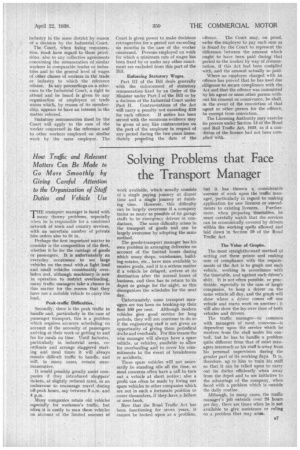Solving Problems that Face the Transport Manager
Page 41

If you've noticed an error in this article please click here to report it so we can fix it.
HE transport manager is faced with 1 many thorny problems, especially when he is responsible for a combined network of town and country services, with an uncertain number of private hire orders also to fit in.
Perhaps the first important matter to consider is the composition of the fleet whether it be for the carriage of goods or passengers. It is unfortunately an everyday occurrence to see large vehicles on the road with pa light load and small vehicles considerably overladen and, although machinery is now in operation to restrict overloading, many traffic managers take a chance in this matter for the reason that they have not a suitable vehicle to carry the load.
Peak-traffic Difficulties, Secondly, there is the peak traffic to handle and, particularly in the case of passenger transport, this is a problem which requires accurate scheduling on account of the necessity of passengers arriving at their work or getting to and fro for meals on time. Until factories, particularly in industrial areas, coordinate and arrange staggered starting and meal times it will always remain difficult traffic to handle, and will, in many cases, remain unremunerative.
It would possibly greatly assist companies if they introduced shoppers' tickets, at slightly reduced rates, in an endeavour to encourage travel during off-peak hours, say between 9 a.m. and 4 p.m.
Many companies retain old vehicles especially for workmen's traffic, but often it is costly to man these vehicles on account of the limited amount of work available, which usually consists of a single paying journey at dinner time and a single journey at finishing time. However, this difficulty can be largely overcome if a company trains as many as possible of its garage staffs to be emergency drivers or conductors. The same difficulty arises in the transport of goods and can be largely overcome by adopting the same method.
The goods-transport manager has his own problem in arranging deliveries on account of the limited hours during which many shops, warehouses, building estates, etc., have men available to receive goods, and it is a serious matter if a vehicle be delayed. arrives at its destination after the normal hours of business, and then has to return to its depot or garage for the night, as this disorganizes the schedules for the next day.
Unfortunately, some transport managers are too keen on booking-up their fleet 100 per cent. Although modern vehicles give good service for long periods, they will not continue to do so if the engineering staff is not given an opportunity of giving them periodical docks and overhauls. For this reason the wise manager will always have a spare vehicle, or vehicles, available to allow for overhauling and to cover his commitments in the event of breakdowns or accidents.
These spare vehicles will not necessarily be standing idle all the time, as most concerns often have a call to turn out a vehicle at short notice ; also a profit can often be made by hiring out spare vehicles to other companies which are not in such a fortunate position to cover themselves, If they have a failure or over-book.
Now that the Road Traffic Act has been functioning for seven years, it cannot be looked upon as a problem, but it has thrown a considerable amount of work upon the traffic manager, particularly in regard to making application for new licences or amendments to existing licences. Furthermore, when preparing timetables, he must carefully watch that the services can be economically covered by drivers within the working spells allowed and laid down in Section 19 of the Road Traffic Act.
The Value of Graphs.
The most straightforward method of setting out these points and making sure of compliance with the requirements of the Act is to graph out each vehicle, working in accordance with the timetable, and against each driver's shift. It is not often possible, or practicable, especially in the case of larger companies, to keep a driver on the same vehicle all day, and the graph will show where a driver comes off one vehicle and starts work on another ; it will also show the lay-over time of both vehicles and drivers.
The traffic manager—in common with managers of most concerns—is dependent upon the service which he receives from the staff under his control, but he has to handle a problem quite different from that of most managers inasmuch as his staff is away from his personal supervision during the greater part of its working days. It is, therefore, up to him to train his staff so that it can be relied upon to carry out its duties efficiently when away from the depot and to use initiative to the advantage of the company, when faced with a problem which is outside the daily routine.
Although, in many cases, the traffic manager's job extends over 24 hours per day, there are times when he is not available to give assistance or ruling on a problem that may arise.


































































































